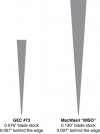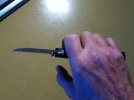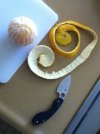Good point about zip ties - you want a beefier blade for that. Not something I do very often with a knife. fwiw, I prefer to twist them off with pliers. Much easier than cutting 90% of the time.
errr. . . might want to do further investigation e.g.
This knife makes ALL OTHERS look silly when it comes to cutting wire ties. The geometry is like 10° per side (I kept reprofiling it until it was the ultimate slicer for cutting precision ends on soft rubber tubing ; oil the blade and tubing first) turns out it cuts wire ties like magic.
Strange but true.
I just measured the spine = 1.8mm ~ 1/16inch
Just when one thinks they know how the universe works . . . BAMMO . . . right ?
View attachment 900813
I've cut a lot of zip ties with a traditional, never dawned on me I needed a beefier blade.






